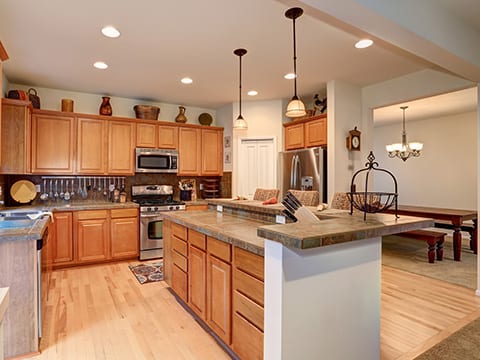Can You Install Vinyl Flooring Over Tile, old, existing tiles!
Vinyl tiles or other forms of vinyl flooring are a great choice for renovating kitchen spaces and bathrooms, more because they are extremely durable and pocket-friendly. The fact that these are resistant to moisture, make them a better option over other flooring choices available these days. That said, vinyl flooring is generally installed on plywood underlayment, but the question is ‘Can you install vinyl flooring over tile?’ Well, time for you to find out!
As with any other renovation/ remodeling projects, preparation is the key. With any flooring installation, preparing the base/ substrate is critical, as that is what prolongs the lifespan of the vinyl flooring on top. As for the answer to your question, yes! You can install vinyl flooring over existing tiles.
Can you install vinyl flooring over tile? Our in-depth answer!
In this section, we will dive deep into the question ‘can you put vinyl floor over tile?’ but before going in-depth, you would first have to understand how it happens. At Floors Blvd, we have often tweaked spaces where we had to lay the vinyl floor directly over an existing ceramic or porcelain floor, however, it is only possible in places where the grout lines are very thin. Moreover, any and all missing/ crack tiles have to be filled in first. However, if there are wide/ deep seams, it is always better to opt for an underlayment instead of installing the vinyl directly on the tiles.
One of the best things about putting the vinyl flooring over an existing tiled surface is that as a homeowner you get to upgrade the look of your place without gutting out your old tiles. This will save you tons of time and labor costs associated with tile removal. Moreover, luxury vinyl flooring is much more cost effective, is extremely easy to maintain, and a lot more durable than tiles or any similar flooring option.
Understanding how vinyl floor planks work
So, now that you know the answer to the question – ‘Can you install vinyl floor over tile?’ we can proceed to the part where we need to understand how vinyl flooring works. But, you are already aware of the flexible vinyl floors, so let’s just focus on another type of vinyl flooring – the gorgeous, luxury vinyl planks!
Unlike hardwood floors, these are quite affordable, and yet, offer the look and feel of the real hardwood floors. In fact, these even install similar to hardwood floors. So, what’s the difference? Well, they are made up of four different layers – the wear layer, the print layer, the core, and the underlayment.
- As the name implies, the wear layer is the top layer, ready to handle the onslaught! It is a clear and protective layer that coats the plank and prevents it from dents, scratches, scuffs, and even UV damage.
- The print layer is the printed sheet that resembles tiles, hardwood floor, or other pattern that you’ve opted for. While some planks have the layer printed, there are other types, where the design is embossed, so it becomes all the more difficult to tell that it’s not real wood.
- The next is the core that gives the flooring its structure and feel. It is either made up of a combination of wood and plastic, or can also be a combination of stone and plastic.
- To all those, who wanted to know – ‘Can you put vinyl floor over tile?’ the underlayment or the subfloor is what gives the vinyl floors its added protection, which in this case will be the tile flooring. The underlayment protects the floor from moisture, and also helps somewhat in soundproofing.
Frequently asked questions
Can you put vinyl floor over tile?
Yes, as a homeowner you can always choose to keep the tiled floor intact and opt for a vinyl floor on top. At Floors Blvd, we make sure that the tile surface underneath is level, clean, and devoid of any damage. Using an underlayment can help in achieving a smooth finish and prevent the grout lines from showing through the vinyl. This is a fairly easy way of updating the look and feel of your place.
What type of vinyl flooring is best for installation over tile?
If you are looking to have a vinyl floor installed on top of an existing tile floor, we’d recommend going for luxury vinyl planks or luxury vinyl tiles. These flooring options are known for their thickness, durability, and the ability to mimic other flooring types. That said, these also offer greater coverage and ensure a smooth finish.
What are the benefits of opting for vinyl flooring over existing tiles?
There are several benefits of doing so, but chief among it is the fact that you end up saving time and money on demolition. The process also offers a smooth and updated look. It makes the floor durable and a lot more water resistant. That’s why, we at Floors Blvd, recommend using vinyl floors. It’s not only easy on the pocket, but is also easy to maintain, comes in many styles, and goes well with almost any decor.

